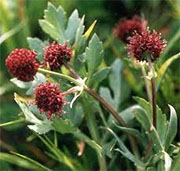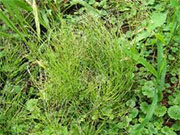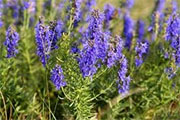Strawberry is famous for its therapeutic qualities. That is why it is often used in folk medicine. Leaves of strawberry are the main part of the plant. They are gathered at the beginning of summer while blossoming. At this period they contain much tannin.
It is hard to say for sure who was the first to notice healing properties of mummy. For a long time scientists could not even say how it appeared. Mummy is found in caves and grottos. The composition of mummy is diverse it contains minerals, chemical elements, and amino acids.
Common burdock or bur is a medicative herb. It can be seen anywhere. Still, very few people know how to use it. Many people think that common burdock is a weed. It can be 1-1,8 meters high, common burdock grows in gardens, dumps, near fences, on waste grounds. Common burdock is a grassy biennial Compositae. The stem of the bur is straight, smooth, ribbed. It has heart-shaped leaves. The root is very long and rod-shaped. Common burdock blossoms in July August. Roots of common burdock are gathered in autumn. They contain inulin, protein, essential oils, organic acids, slime, tannin, bitter stuff, and many other useful substances.

Common avens (sanicle) is a perennial herb. It is widely spread in European part of Russia, in the Caucasus, almost in all countries of Europe, North Africa, and Australia. The most important part of the plant is the root. It is widely used in medicine. Rhizomes of common avens are gathered in autumn. It is desirable to look for plants older than 2 years. Common avens is reach in essential oils and tannin.
Barberry is a thornbush with small gold yellow sweet-scented flowers. Barberry blossoms in May-June. Even though barberry was originally grown in Africa, it is very popular in Ukraine, Russia, in the Caucasus. It mostly grows in woods, on sidehills, in ravines.
Blackberry (Rubus caesius L) is rather a widespread plant in Europe. It grows near rivers, lakes, and in woods. Many gardeners grow blackberry in their gardens. Fruit and leaves of blackberry as well as its roots and stems are very useful. Blackberry leaves are used to make decoctions. With their help one can treat diseases of the upper respiratory tracts.

Field horsetail is a perennial herb. Actually it is a couch grass. The roots of field horsetail grow deep. The plant is unpretentious and can easily grow in difficult environments. Field horsetail looks like a grassy firtree 30 centimeters high. Field horsetail is a cryptogamic plant. The first stems of field horsetail appear in spring. They have spikelets of spores on them. As the spores are mature, fir-like stems appear. Grassy part of field horsetail is frequently used in medicine. Chemical composition of field horsetail is diverse: it contains alkaloids, saponins, bitter, tannin, vitamins B, C, carotin, gums, organic acids, and many other useful substances. Field horsetail is gathered when the spores are mature. Eventually, one will gather only fir-like stems.

Hyssop is the second name of Saint-John's-wort. It is a lip-flowered plant. Hyssop is usually 50-60 centimeters high. The plant is a subshrub with oblong or linear leaves or a redolent perennial herb. Flowers are usually blue, of irregular shape. They form spike-shaped blossom clusters. Hyssop grows in Asia and Russia mostly in dry places like steppes, rocky slopes and dry hills.
Marigold is a popular medicative herb and can be easily grown in every garden. Just keep in mind that marigold likes damp and sunny places. Upon the whole marigold is an unpretentious and cold-resistant plant. Wild marigold grows in Mediterranean countries, in Central and Southern Europe. Blossom cluster of marigold are widely used in folk medicine. Flowers are collected while blossoming (from midsummer to late autumn).
Cats-foot is spread in subarctic and moderately continental climatic zones of Europe, North America and Asia. Cats-foot is a light-requiring plant growing mostly on sands, in pine forests, dry meadows and moorlands. The herb itself as well as its flowers is used in medicine. They are gathered while blossoming. Cats-foot contains gums, saponins, tannin, vitamin K, and alkaloids.